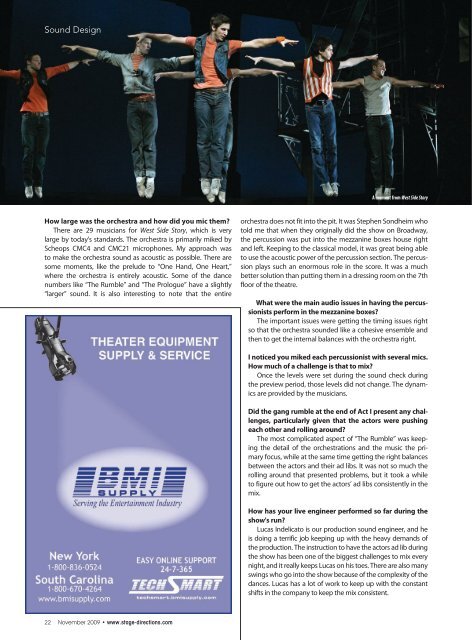Download a PDF - Stage Directions Magazine
Download a PDF - Stage Directions Magazine
Download a PDF - Stage Directions Magazine
You also want an ePaper? Increase the reach of your titles
YUMPU automatically turns print PDFs into web optimized ePapers that Google loves.
Sound Design<br />
A moment from West Side Story<br />
How large was the orchestra and how did you mic them?<br />
There are 29 musicians for West Side Story, which is very<br />
large by today's standards. The orchestra is primarily miked by<br />
Scheops CMC4 and CMC21 microphones. My approach was<br />
to make the orchestra sound as acoustic as possible. There are<br />
some moments, like the prelude to “One Hand, One Heart,”<br />
where the orchestra is entirely acoustic. Some of the dance<br />
numbers like “The Rumble” and “The Prologue” have a slightly<br />
“larger” sound. It is also interesting to noteethat the entire<br />
orchestra does not fit into the pit. It was Stephen Sondheim who<br />
told me that when they originally did the show on Broadway,<br />
the percussion was put into the mezzanine boxes house right<br />
and left. Keeping to the classical model, it was great being able<br />
to use the acoustic power of the percussion section. The percussion<br />
plays such an enormous role in the score. It was a much<br />
better solution than putting them in a dressing room on the 7th<br />
floor of the theatre.<br />
What were the main audio issues in having the percussionists<br />
perform in the mezzanine boxes?<br />
The important issues were getting the timing issues right<br />
so that the orchestra sounded like a cohesive ensemble and<br />
then to get the internal balances with the orchestra right.<br />
I noticed you miked each percussionist with several mics.<br />
How much of a challenge is that to mix?<br />
Once the levels were set during the sound check during<br />
the preview period, those levels did not change. The dynamics<br />
are provided by the musicians.<br />
Did the gang rumble at the end of Act I present any challenges,<br />
particularly given that the actors were pushing<br />
each other and rolling around?<br />
The most complicated aspect of “The Rumble” was keeping<br />
the detail of the orchestrations and the music the primary<br />
focus, while at the same time getting the right balances<br />
between the actors and their ad libs. It was not so much the<br />
rolling around that presented problems, but it took a while<br />
to figure out how to get the actors’ ad libs consistently in the<br />
mix.<br />
How has your live engineer performed so far during the<br />
show's run?<br />
Lucas Indelicato is our production sound engineer, and he<br />
is doing a terrific job keeping up with the heavy demands of<br />
the production. The instruction to have the actors ad lib during<br />
the show has been one of the biggest challenges to mix every<br />
night, and it really keeps Lucas on his toes. There are also many<br />
swings who go into the show because of the complexity of the<br />
dances. Lucas has a lot of work to keep up with the constant<br />
shifts in the company to keep the mix consistent.<br />
22 November 2009 • www.stage-directions.com

















